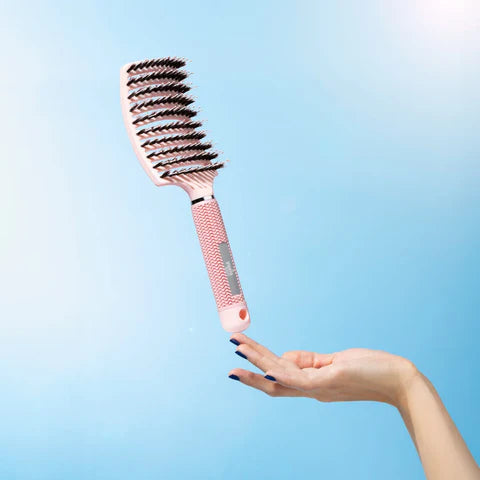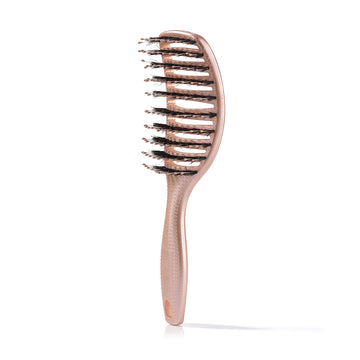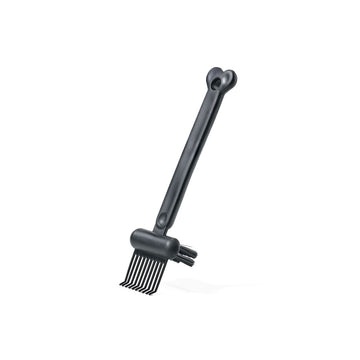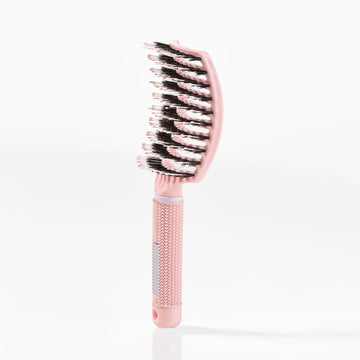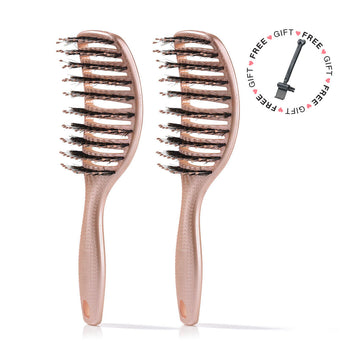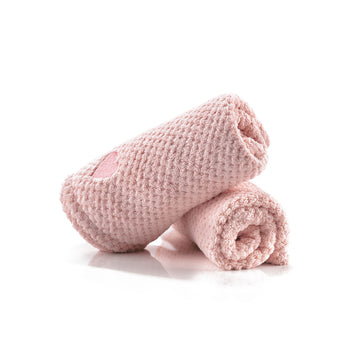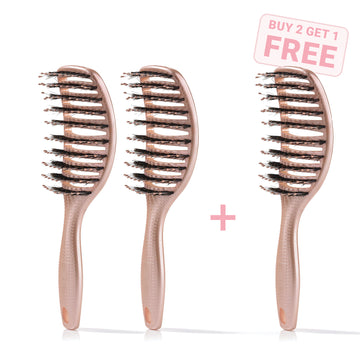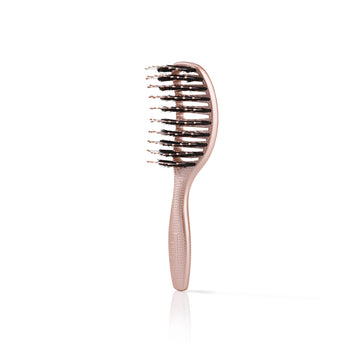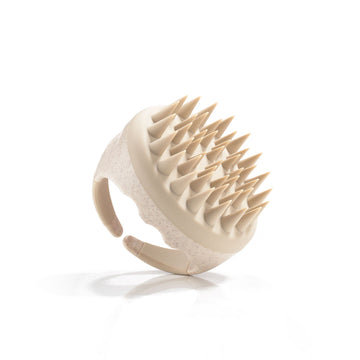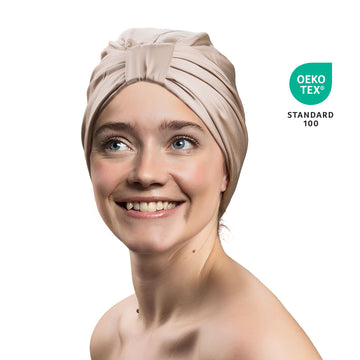Hair loss men: Effective methods to reduce hair loss
Excellent Based on 5783 reviews
What is baldness or androgenic alopecia?
Baldness is the most common form of hair loss in men, and it is usually known as androgenetic alopecia. It is a condition where you slowly start to have thinning hair and eventually end up with complete hair loss. The vast majority of men are affected by androgenetic alopecia at some point in their lives. But it is different when in life you start to experience baldness. Statistics show that up to a third of all men will experience hair loss before the age of 30.
Thinning hair in men
Androgenic alopecia is an inherited condition, which can mean that some men will begin to experience thinning hair and baldness in their early twenties. A receding hairline is the first indication of thinning hair, which then triggers high temples and a thinning of the hair. Eventually, the hair can become so thin that it results in complete baldness.
When will I lose too much hair?
Do you often think, am I losing too much hair? Is my hair thinning? Just because you see strands of hair falling out, you don't need to panic. It is normal for us to lose between 50 and 100 hairs a day, because strands of hair go through a growth cycle, where some are terminated and others are started.
But if you notice that you suddenly start to lose a lot of hair or that the high temples start to press in, you can consider looking into how you can put an end to the hair loss. But in order to get started properly, it is important that you find out what the reason behind the hair loss is. It can often come in many different shapes and sizes.
Why do men lose their hair?
You can already start preparing yourself for the fact that sooner or later you will be affected by hair loss and baldness to a lesser or greater degree. Below we have listed the most common reasons why you lose your hair as a man.
- Androgenic alopecia is undoubtedly the most frequent cause of male pattern baldness and hair loss. The hereditary condition is responsible for 9 out of 10 men losing their hair and experiencing baldness. Since it is a hereditary cause, there is not much you can do other than try to prevent it.
- Diet can also have an effect on male pattern baldness. If you, as a man, do not get the sufficient vitamins that your body needs, it can end up with baldness.
- Feeling stressed can also result in baldness and hair loss. Stress creates a hormonal imbalance, which interrupts the hair's natural growth process.
- If you suffer from a certain disease, it can also result in baldness or hair loss. It could, for example, be a disease of the scalp such as alopecia areata, baldness, or other skin diseases.
Read more about the causes of hair loss and baldness among men.
High temples in men
Many men also suffer from high temples as a result of thinning hair. High temples occur when the hairline slowly begins to recede at the sides. This results in a splendour, where you are partially bald in some places, and this can lead to many men choosing to cut themselves completely bald, because they want to avoid the high temples and the very thin hair. Read more about high temples here.
Can men get their hair back?
In some cases, men can regrow lost hair or even stop hair loss if the cause of their baldness or thinning is treated early. However, it is important to note that the effectiveness of any treatment depends on the underlying cause of hair loss. Depending on the cause, there are several treatments available that men can use to regrow their hair.
Psychological Effects of Hair Loss in Men: Coping and Solutions
Hair loss can have a profound psychological impact on men, often leading to low self-esteem, anxiety and depression. For many men, hair is an important part of their identity and confidence, and its loss can feel like a loss of masculinity and youth. Here is an in-depth exploration of the psychological effects of hair loss in men, as well as strategies for dealing with them.
The Psychological Consequences of Hair Loss
- Low self-esteem:
- Hair loss can lead to a significant decline in self-esteem, as men often associate their hair with their appearance and attractiveness. When hair starts to fall out, it can result in feelings of inadequacy and inferiority.
- Social Anxiety:
- Many men experience social anxiety as a result of hair loss. They may feel embarrassed or self-conscious about their appearance, which can make them more withdrawn and less likely to participate in social activities.
- Depression:
- Hair loss can lead to depression in some cases. Feelings of sadness and loss can arise, and the ongoing stress over appearance can lead to a deeper emotional downturn.
- Body dysmorphia:
- Some men develop body dysmorphia disorder, where they become obsessed with their appearance and experience excessive worry over their hair loss. This can lead to constant mirror checking and avoidance of situations where they feel exposed.
Treatment options for hair loss in men
When it comes to treating hair loss in men, there are several effective methods to consider, both medical and natural. These treatments can help slow hair loss, stimulate new hair growth and improve overall hair health.
Medical Treatments
- Minoxidil:
-
How it works: Minoxidil is an FDA-approved topical solution that is applied directly to the scalp. It works by expanding hair follicles and prolonging the growth phase of the hair cycle.
-
Effectiveness: Clinical studies have shown that minoxidil can promote hair growth in up to 60% of users with regular use over several months. It is available in 2% and 5% strengths.
-
Side effects: Some users may experience scalp irritation or unwanted hair growth on other parts of the body.
- Finasteride:
-
How it works: Finasteride is a prescription oral medication that reduces the conversion of testosterone to dihydrotestosterone (DHT), a hormone that damages hair follicles.
-
Effectiveness: Studies have shown that finasteride can reduce hair loss and promote new growth in many men with androgenetic alopecia (male pattern baldness).
-
Side effects: Potential side effects include decreased libido, erectile dysfunction and a small risk of breast cancer.
- PRP (Platelet-Rich Plasma) Treatment:
-
How it works: PRP therapy involves injecting the patient's own platelet-rich plasma into the scalp to stimulate hair follicles and promote growth.
-
Effectiveness: Several studies have reported increased hair thickness and growth after regular PRP treatments.
-
Side effects: Minimal risk of infection or pain at the injection site.

Natural Treatment Options
- Essential Oils:
-
How they work: Oils such as rosemary and lavender oil can improve blood circulation in the scalp and stimulate hair follicles.
-
Effectiveness: One study found that rosemary oil was as effective as minoxidil in promoting hair growth over a six-month period.
-
Usage: Massage essential oils diluted in a carrier oil (such as coconut or jojoba oil) into the scalp several times a week.
- Supplements:
-
How they work: Vitamins and minerals such as biotin, zinc, iron and vitamin D play an important role in maintaining healthy hair.
-
Effectiveness: A lack of these nutrients can lead to hair loss, so supplementation can help restore hair health.
-
Use: Take daily as directed on the supplement label.
- Scalp Massage:
-
How it works: Regularly massaging the scalp increases blood circulation and can stimulate hair growth.
-
Effectiveness: A small study showed that men who massaged their scalp daily for four minutes experienced an increase in hair thickness.
-
Usage: Use your fingers or a special scalp massager to massage the scalp daily for a few minutes.
- Capilia Longa:
-
How it works: Capilia Longa is a natural extract from the turmeric plant that has been studied for its hair growth promoting properties. It works by revitalising hair follicles and prolonging the hair growth phase.
-
Effectiveness: Clinical studies have shown that Capilia Longa can increase hair density and thickness with regular use. It is known to reduce hair loss and promote healthy hair growth.
-
Usage: Capilia Longa is often found in serums and hair care products. Use these products as directed, typically by massaging them into the scalp daily or several times a week.
By combining these methods, men can find a treatment plan that works best for them. It's important to consult a doctor or dermatologist for a personalised recommendation based on individual needs and medical history.
Hair transplant for men: A guide to the process
Hair transplantation has become a popular and effective solution for men suffering from hair loss. This procedure involves moving hair follicles from an area with thick hair to an area with thin or no hair. Here is a detailed guide to what to expect from a hair transplant, the different methods and the results you can achieve.
Methods for hair transplantation
- FUT (Follicular Unit Transplantation):
-
How it works: In FUT, a strip of skin is removed from the donor area (typically the back of the head) and individual hair follicles are harvested under a microscope. These grafts are then inserted into the recipient area.
-
Pros: Can transplant a large number of follicles at once, which is good for those with extensive hair loss.
-
Cons: Leaves a visible scar in the donor area and requires longer healing time.
- FUE (Follicular Unit Extraction):
-
How it works: In FUE, individual hair follicles are extracted directly from the donor area using a specialised tool and inserted into the recipient area.
-
Pros: Leaves no visible scars and has a shorter healing time compared to FUT.
-
Cons: The procedure can be time-consuming and more expensive as each follicle is removed individually.
What to expect
Preparation: Before the procedure, you will have a consultation with a hair transplant specialist who will assess your hair loss, discuss your goals and explain which method is best for you. You may be asked to avoid certain medications and stop smoking before the procedure to promote healing.
During the procedure: Hair transplantation is usually performed under local anaesthetic. The procedure itself can take several hours, depending on how many follicles are being transplanted. During FUT, you will see a strip of skin removed, while FUE involves the removal of individual follicles.
Aftercare: After the procedure, you may experience some pain, swelling and redness in both the donor and recipient areas. Your doctor will give you instructions on how to care for your scalp and what activities you should avoid during the healing period. It is important to follow these instructions carefully to ensure the best results.
Results
Early Phase: In the first few weeks after the transplant, the transplanted hair follicles will fall out - this is a normal part of the healing process. New hair growth usually begins within three to four months.
Long-term Results: The full results of a hair transplant can be seen after 9-12 months, when the new hair is fully grown and integrated with the existing hair. The results are permanent as the transplanted follicles are genetically resistant to hair loss.
Expectations: Although hair transplantation can provide remarkable results, it is important to have realistic expectations. Hair transplantation cannot create new follicles, but moves existing ones to new areas. Results also depend on the quality and quantity of donor hair.
Conclusion
Hair transplantation can be a highly effective solution for men suffering from hair loss. With modern techniques such as FUT and FUE, patients can achieve natural and long-lasting results. It is important to consult an experienced specialist and follow aftercare advice carefully to achieve the best results.
10 Good tips for preventing hair loss in men
1. Turn down the hot water when washing your hair as it can damage the hair follicles and lead to hair loss.
2. Use a mild shampoo and conditioner and choose products designed to strengthen hair and prevent hair loss. Here we can highly recommend the Grow and Glow Shampoo.
3. Massage the scalp with your fingers or a soft brush when you wash your hair, as this can stimulate blood circulation and promote hair growth. The perfect brush for this is our Deep Scalp Brush.
4. Avoid using too much styling products as they can clog the follicles and cause hair loss. Excessive use of styling products such as gels, waxes and sprays can damage the scalp and lead to hair loss and thinning over time. If you must style your hair, choose gentle products that are free of harsh chemicals. Here, it is particularly important to look for silicone and sulfates.
5. Eat a healthy and varied diet that contains lots of vitamins and minerals, especially biotin as it helps to maintain normal hair. Eating foods rich in protein, omega-3 fatty acids, zinc and iron can help maintain normal hair growth. Feel free to supplement your diet with plenty of fruit and vegetables to achieve a good, healthy and varied diet. In particular, you must pay attention to getting good food that contains biotin and zinc, as these vitamins and minerals help to maintain normal hair.
6. Avoid pulling on your hair when it is wet as it can be more fragile and easier to come off. The hair is very fragile when it is wet, so pay close attention to the hair there.
7. Try to avoid using tight hairstyles or clips as they can damage the hair strands. In general, minimize the use of styling, especially be careful with heat styling.
8. Practice regular exercise, as it helps to oxygenate the blood which can increase blood circulation and thus promote hair growth. Exercise is incredibly important for overall health and well-being; it has been shown to lower stress levels, which helps reduce the risk of hair loss or thinning hair in men due to hormonal imbalances caused by stress.
9. Avoid alcohol and smoking. it's no secret that these 2 things are generally not good for our health, but did you know that it can go beyond your hair and end up with, for example, hair loss?
Smoking and alcohol can have a very negative effect on hair loss or thinning hair in men. Smoking cigarettes exposes the body to an abundance of chemicals and toxins, some of which are known to disrupt metabolism and circulation, both of which are essential for a healthy scalp and hair growth. When circulation is reduced due to smoking, it can affect the ability to grow new hair properly, leading to thinning or baldness. Also, these toxins from cigarettes can weaken the existing hairs on the head, making them more likely to break.
Alcohol consumption also has a direct correlation with thinning hair in men. Alcohol weakens the immune system and disrupts protein synthesis in the body, both of which affect how many nutrients reach the scalp. In addition, heavy consumption of alcohol can lead to dehydration, which reduces the essential minerals that the scalp and hair follicles need to produce a healthy strand of hair.
10. If you notice a sudden or persistent loss of hair, you should see a doctor for a diagnosis and advice on treatment. This can make it much easier to treat or prevent it. If you feel you have done everything to try to avoid hair loss or thinning hair, it can sometimes often be the best idea to have a talk with the doctor.
Products for hair loss.
If you, as a man, want good advice on how to treat hair loss or baldness, then you should read along here. It is possible to prevent it, so you can reduce the degree of hair loss.
To treat hair loss and baldness, it is essential to use hair products that are, among other things, sulfate-free. Read more about why you should choose a sulfate-free shampoo. The following three products are particularly good to use in the treatment of hair loss in men:
-
Grow and Glow Hair Serum helps to boost your hair growth so that your hair can grow stronger. The product contains Capilia Longa, which has been shown to reduce hair loss by up to 89% and increase hair density by 52% after 150 days of use. If you want to read more about the ingredient Capilia Longa and its results, read here.
- Grow and Glow Shampoo, which is both sulfate-free and silicone-free, which helps to stimulate hair growth and reduce hair loss. The product also contains Capilia Longa, so the hair becomes stronger and denser.
-
Grow and Glow Conditioner, which, like the shampoo, is also both sulphate-free and silicone-free. The product also contains Capilia Longa and penetrates the hair roots so that the hair strands are strengthened.
To avoid high temples, hair loss or baldness, you can also go for a specific diet that contains vitamins that can play a role in relation to the hair. You can also get a pillow with a bamboo cover that is gentle on both hair and is soft as silk.
If you are very burdened by hair loss, you can consider a hair transplant, which lasts a lifetime because viable donor hair is used, which has a natural growth.
Good products against hair loss
Myths about Male Pattern Hair Loss: Revealing Common Misconceptions
Male hair loss is surrounded by many myths and misconceptions that can cause unnecessary worry and confusion. Understanding the truth behind these myths can help you make better decisions about hair loss treatment and prevention. Here are some of the most common myths about male pattern hair loss and the truth behind them.
Myth 1: Only older men lose hair
Truth: Hair loss can begin at any age, and it's not uncommon to see men in their 20s or even teens experience early hair loss. Androgenetic alopecia, also known as male pattern baldness, can begin as early as the teenage years and becomes more common with age.
Myth 2: Hair loss is inherited from the mother
Reality: It's a common misconception that hair loss is inherited exclusively from the mother's side of the family. In fact, genes from both sides of the family can contribute to male pattern baldness. Research has shown that both maternal and paternal genetic inheritance can influence the risk of hair loss.
Myth 3: Hair washing causes hair loss
Reality: Hair washing in itself does not cause hair loss. Although it may seem like you lose a lot of hair in the shower, it's normal for hair to fall out during washing and combing. This hair is already in the natural resting phase and will be replaced by new hair.
Get a 10% discount code sent to you
Receive the best tips and tricks for your hair from Lotte and Nanna 🥰
Myth 4: Wearing a hat leads to hair loss
Truth: Wearing a hat or cap does not lead to hair loss. Hair loss is caused by genetic and hormonal factors, not external influences like wearing a headgear. As long as the hat is not so tight that it interferes with blood circulation in the scalp, there is no risk of hair loss.
Myth 5: Stress is the primary cause of hair loss
Truth: While severe stress can contribute to temporary hair loss in the form of telogen effluvium, it is rarely the primary cause of permanent hair loss in men. Androgenetic alopecia is the most common cause of hair loss in men and is caused by hormonal and genetic factors. However, stress can exacerbate existing hair loss and should be managed to maintain overall health.
Myth 6: Hair loss can be stopped with supplements alone
Truth: Supplements can help improve hair health and strength, but they can rarely stop genetic or hormonal hair loss alone. Treatments like minoxidil and finasteride, combined with a healthy lifestyle, may be necessary to effectively manage hair loss.
Myth 7: Hair loss is caused by poor circulation in the scalp
Reality: There is no scientific evidence to support the idea that poor circulation in the scalp causes hair loss. Hair loss is primarily due to genetic and hormonal factors, and while good circulation is important for scalp health, it is not the primary cause of hair loss.
Frequently Asked Questions
What are the main causes of hair loss in men?
The main causes of hair loss in men include genetic factors (androgenetic alopecia), hormonal changes, poor diet, stress, and certain medical conditions. Genetics is the most common cause, but lifestyle and health can also play a significant role.
Can hair loss in men be reversed?
Hair loss can sometimes be reversed or slowed, especially if addressed early. Treatments like minoxidil, finasteride, and PRP therapy can help, as well as lifestyle changes and proper hair care. However, results vary depending on the underlying cause and individual response to treatment.
Are there natural remedies that help with male hair loss?
Yes, natural remedies such as essential oils (like rosemary oil), scalp massage, and dietary supplements (biotin, zinc, vitamin D) may help improve hair health and reduce hair loss. While these methods can support hair growth, they are most effective when combined with medical treatments for genetic hair loss.
Is a hair transplant a permanent solution for baldness?
Hair transplants are considered a permanent solution because the transplanted hair follicles are resistant to the hormones that cause hair loss. However, it's important to have realistic expectations, as the procedure redistributes existing hair rather than creating new follicles.
When should I see a doctor about hair loss?
You should see a doctor if you notice sudden, patchy, or excessive hair loss, or if you have concerns about your scalp health. A healthcare professional can help diagnose the cause and recommend appropriate treatment options.
 2-5 day delivery
2-5 day delivery
 25.000+ satisfied customers
25.000+ satisfied customers
 Satisfaction Guarantee
Satisfaction Guarantee





